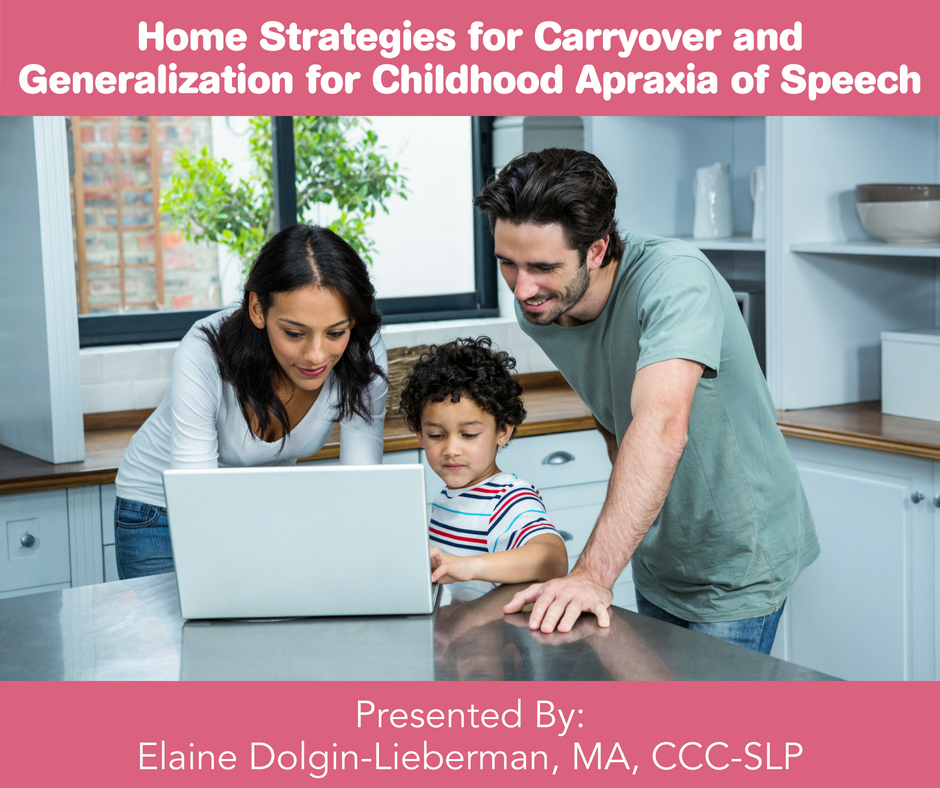
14 Dec Home Strategies for Carryover and Generalization for Childhood Apraxia of Speech
Course Abstract:
Parent involvement is critical to achieving successful outcomes in children with childhood apraxia of speech. Research conducted by Edal and Gildersleeve-Neumann (2011) found that the more production targets are practiced, the faster a child can acquire the targets and better the chance for generalization. This presentation will focus on ways speech-language pathologists can include parents, families, and caregivers in the therapy process to increase home practice. This can enhance the child’s rate of progress, generalization, and self-esteem that results from their feeling of success and improved speech clarity.
The aim of this presentation is two-fold:
- Review of the evidence supporting parent/caregiver involvement in the treatment of children with CAS and other pediatric speech sound disorders
- Discuss techniques that therapists can share with parents that they can then employ at home with children ranging from those who are minimally verbal through older children with residual speech issues using the principles of motor learning
Presented By: Elaine Dolgin-Lieberman, M.A., CCC-SLP
This course is offered for 0.15 ASHA CEU’s (Intermediate level, Professional area)

Learning Objectives
- Describe the need for parent involvement and understand the important role parents can play in the therapeutic process
- Identify a strategy that parents can use with children in home practice within each phase of the Principles of Motor Learning (PML) framework, including pre-practice, practice, and feedback
Timed Agenda
Minutes 1-10: Importance of parent involvement- what can the SLP do to encourage parent involvement
Minutes 11-20: Home strategies/activities to facilitate pre-practice within a MLT framework
Minutes 21-30: Home strategies/activities for children who are minimally verbal with suspected CAS
Minutes 31-45: Home activities for practice/activities for preschool children with CAS to facilitate sound production, literacy, and prosody
Minutes 46-56: Manual home strategies/activities for elementary-aged children, including later developing sounds, literacy, and prosody
Minutes 56-65: Strategies to provide effective feedback
Minutes 66-70: Conclusion
Minutes 71-90: Questions and Answers
Course Abstract:
Parent involvement is critical to achieving successful outcomes in children with childhood apraxia of speech. Research conducted by Edal and Gildersleeve-Neumann (2011) found that the more production targets are practiced, the faster a child can acquire the targets and better the chance for generalization. This presentation will focus on ways speech-language pathologists can include parents, families, and caregivers in the therapy process to increase home practice. This can enhance the child’s rate of progress, generalization, and self-esteem that results from their feeling of success and improved speech clarity.
The aim of this presentation is two-fold:
- Review of the evidence supporting parent/caregiver involvement in the treatment of children with CAS and other pediatric speech sound disorders
- Discuss techniques that therapists can share with parents that they can then employ at home with children ranging from those who are minimally verbal through older children with residual speech issues using the principles of motor learning
Presented By: Elaine Dolgin-Lieberman, M.A., CCC-SLP
This course is offered for 0.15 ASHA CEU’s (Intermediate level, Professional area)

Learning Objectives
- Describe the need for parent involvement and understand the important role parents can play in the therapeutic process
- Identify a strategy that parents can use with children in home practice within each phase of the Principles of Motor Learning (PML) framework, including pre-practice, practice, and feedback
Timed Agenda
Minutes 1-10: Importance of parent involvement- what can the SLP do to encourage parent involvement
Minutes 11-20: Home strategies/activities to facilitate pre-practice within a MLT framework
Minutes 21-30: Home strategies/activities for children who are minimally verbal with suspected CAS
Minutes 31-45: Home activities for practice/activities for preschool children with CAS to facilitate sound production, literacy, and prosody
Minutes 46-56: Manual home strategies/activities for elementary-aged children, including later developing sounds, literacy, and prosody
Minutes 56-65: Strategies to provide effective feedback
Minutes 66-70: Conclusion
Minutes 71-90: Questions and Answers
Credentials:
Hours of Operation:
Treatment locations:
Address:
,
Phone:
Email:
Overall Treatment Approach:
Percent of CAS cases:
Parent Involvement:
Community Involvement:
Professional consultation/collaboration:
Min Age Treated:
Max Age Treated:
Insurance Accepted:




